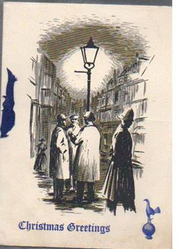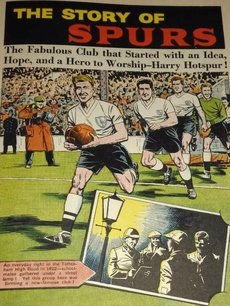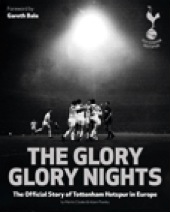 Few things are certain in life, one of them is that as the autumn nights turn to dusk and the light becomes too poor to continue playing you will find two things under a lamppost both drawn by the last light. The first are night time insects the other is schoolboys putting off returning home after an evening’s play. Thus it was in the late summer 1882 a group of school friends slowly wound their way up Marsh Lane from the level crossing at Northumberland Park Station towards Tottenham High Road. They had been playing cricket, having formed their own team two summers previously, and played on a piece of land owned by the uncle of several of the boys. The story of how they stood under a lamppost and formed the Spurs is sometimes considered apocryphal but we can be fairly sure that the conversation of how to fill the winter evenings had been discussed at length over the proceeding weeks. Various witnesses in later years have pointed out the spot where much of this debate was held. A gas lit lamppost on the western side of the High Road just short of the junction with Marsh (now Park) Lane. It’s been suggested that they debated the merits of following the rugby football rules. Luckily for us they decided to adopt the association game. Of which there were various sets of rules being used at the time despite the Football Association having been in existence for just twenty years, (1). The prime instigators are credited as Bobby Buckle (2), Hamilton Casey and John Anderson. The boys, mostly 13 and 14 years of age at the time, came from good homes and attended either Tottenham Grammar School or the local Presbyterian school, St. John’s. As is the way of the world every group becomes known by a nickname. Our founders tended to be known as ‘the Saints’ or the ’Northumberland Pups.’ Whilst other groups made up from families of local tradesmen and attending other schools carried such titles as ‘the Bulldogs’ and ‘the Cads’. There was certainly bad feeling between the various groups which would ran much deeper than just football with several instances of fights between the groups being recorded. A set of club rules was arranged and subscriptions set at sixpence. The first of these were paid on Tuesday 5th September 1882 and that date is taken as the official formation of the side. The name Hotspur was transferred from their Hotspur Cricket Club. The area once being owned by the Earl of Northumberland and the area is still riddled with names and references to the family. The most famous member of the same is Harry Hotspur who has been immortalized by historians and Shakespeare. He died at the battle of Shrewsbury in 1403 and had a reputation of enjoying a ‘good scrap’ and not sparing his mount the use of his spurs. If the boys had any inkling of what they were starting they may have kept more extensive records, but as with most clubs of the time we have little evidence of their first encounters. Although coming from middle class backgrounds Hotspur tended to be more formal in their approach. The team played their first games on the Tottenham Marshes and the first game we have any record of was four weekends later on the 30th September against another Marshes based side the Radicals, (3). This resulted in a 0-2 defeat. It’s thought this was counted as a home fixture re the purchase of a ball on the day (4). Other games from that season have slipped into history. The only other game we have a record of that first season was on January 6th against Latymer, away, and a heavy 1-8 loss to a team from the Edmonton school of that name who were older than our own side, (5). No details (including that of our scorer) have survived from these games. Again we must remember that we had a group of schoolboys, organized, but they were looking forward, whilst last week’s game was no doubt recorded in ink in a note book at the time the idea that it would be of interest to us more than 130 years in the future would be as likely to them as traveling to the moon.
Other boys joining during the season and who had not been in the cricket club were charged a shilling these were. D. Davies, C. Iversen, John Fisher, Tom Bumberry, R. Howlett and Billy Tyrell and Lovell (8). The older histories suggest more boys wanted to join but with 18 playing members ‘we were not keen to on letting others in.’ It was an uncle of the Thompsons, (there were six brothers in total, ‘and all good sporting types’) a Captain William Delano, who provided the cricket pitch and this could be found as you cross the level crossing on the left. Lindsay Casey would act as the clubs first treasurer. It is often written that the father of the Casey’s provided the first goalposts. The wood was actually purchased for goal posts and corner flags and then fashioned by Mr. Casey and maybe with incredible foresight he painted them blue and white. Those first purchases by the ‘club’ also included material for the flags, tape (for the use as a crossbar) stationary and stamps. You may have noticed like crossbars (they were becoming more popular but were not yet compulsory) there were no nets at this point. There are reports of games (not necessary Spurs) at this time where the goalkeepers would jump and put the tape downwards to allow the ball to go ‘over the bar’. One of the Casey’s older brothers is credited with providing the first ball the club owned, although a new one was purchased for that first game. The same brother is thought to have originally suggested Hotspur for the name of the cricket club. John Thompson took on the role of secretary. That first season provided various obstacles and as the first season came to a close Hotspur could of disappeared except for the determination of its members who knew even at that tender age if they were to survive they needed to be more organized and sought adult guidance.
Just 21 years later the team would win the English Cup and (not to mention play in front of a world record crowd) become a household name throughout the land and as the newspapers reached out around the Globe so did its reputation. Today, that club having never moved away from its roots is building a new stadium on the same site they moved into in 1899 just a few yards from that lamppost. What happened next is covered in the forthcoming series ‘A Victorian Hotspur.’ COYS Keith Harrison. t- Keith 16024542 f - https://www.facebook.com/keith.harrison.9659 You can my full archive at - View Full Bio See also – ‘Talking Tottenham – 1882 and All That’ & ‘Adventures in N17’ Acknowledgements can be found in Talking Tottenham – 1882 and all that, published yesterday. http://www.indiaspurs.com/blog/talking-tottenham-adventures-in-n17 Top Image - The clubs Christmas card from 1959, even if the boys look a little on the tall side. Notes – 1 – The FA had been formed as early as 1863. The FA Cup had been first competed for in 1871/72 and the Football League won’t start until 1888/9. 2 – Bobby Buckle link –http://www.indiaspurs.com/blog/hotspur-towers-bobby-buckle 3 - The Radicals were a well organized local side of mostly older players and whose matches in the season 1882/83 were being reported in the Weekly Herald. It is no surprise they were our first opponents as Ham Casey had played for them the year before, the only one of the founders with any experience. 4 – It would be boring to reference every slight variation in the various records. For instance the score 0-2 is given in Bob Goodwin’s Complete Record whilst in Phil Soar’s official history it is recorded as venue and score unknown but lost by two goals. I’ve attempted throughout to go with the consensus amongst ‘reliable’ sources. 5 - Some respectable sources have said the first game was with Latymer although this appears to be incorrect. The encounters with Latymer and their underhanded approach to the game are discussed in The Latymer Incident – Link -http://www.indiaspurs.com/blog/hotspur-towers-20 6 – The Romance of Football was published in 1921 by The Weekly Herald and draws upon its previous reports of the club and interviews with various people associated with it including a number of the founders. Therefore whilst we can assume it’s ‘reasonably ‘accurate there are some points that appear questionable as we will discover later in the series. 7 – The Rise and Progress of ‘The Spurs’. Believed to have been written in 1897 and was authored by “Old Crock.” Whilst we can’t be positive of this writers identity L Casey has been suggested. 8 - Julian Holland’s history suggests this could be an error and it may be either F. Lovis or W. Lomas both would be regular players in the following season.
0 Comments
Leave a Reply. |
Features
Flying Down to Rio History of T.H.F.C. Tribute to Bill Nicholson Talking Tottenham Early Legends The Road to Turin International Connections Hotspur Towers Most Read Articles
The 100 Year War Interview with Marina Sirtis A Long Dark Shadow By Royal Appointment School Report: An Insight into the Younger Eric Dier Dear Jimmy All Change At Spurs Hotspur Towers History Of THFC: Part 1 Passage to India: Rohan Rickets Thanks For The Memories Our Tommy Carroll The AVB Files: Part1 The Lilywhites You The Jury The Hand Of Hugo Connection - Argentina Creating a Reputation One Hotspur Archives
August 2018
Categories
All
|

 RSS Feed
RSS Feed

